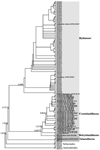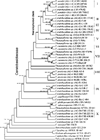Phylogenetic relationships of Rhizoctonia fungi within the Cantharellales
- PMID: 27020160
- PMCID: PMC5013834
- DOI: 10.1016/j.funbio.2016.01.012
Phylogenetic relationships of Rhizoctonia fungi within the Cantharellales
Abstract
Phylogenetic relationships of Rhizoctonia fungi within the order Cantharellales were studied using sequence data from portions of the ribosomal DNA cluster regions ITS-LSU, rpb2, tef1, and atp6 for 50 taxa, and public sequence data from the rpb2 locus for 165 taxa. Data sets were analysed individually and combined using Maximum Parsimony, Maximum Likelihood, and Bayesian Phylogenetic Inference methods. All analyses supported the monophyly of the family Ceratobasidiaceae, which comprises the genera Ceratobasidium and Thanatephorus. Multi-locus analysis revealed 10 well-supported monophyletic groups that were consistent with previous separation into anastomosis groups based on hyphal fusion criteria. This analysis coupled with analyses of a larger sample of 165 rpb2 sequences of fungi in the Cantharellales supported a sister relationship between the Botryobasidiaceae and Ceratobasidiaceae and a sister relationship of the Tulasnellaceae with the rest of the Cantharellales. The inclusion of additional sequence data did not clarify incongruences observed in previous studies of Rhizoctonia fungi in the Cantharellales based on analyses of a single or multiple genes. The diversity of ecological and morphological characters associated with these fungi requires further investigation on character evolution for re-evaluating homologous and homoplasious characters.
Keywords: Fungal plant pathogens; Multi-locus phylogeny; Rhizoctonia anamorphs; Rhizoctonia solani.
Copyright © 2016 The British Mycological Society. Published by Elsevier Ltd. All rights reserved.
Figures




Similar articles
-
Contributions of rpb2 and tef1 to the phylogeny of mushrooms and allies (Basidiomycota, Fungi).Mol Phylogenet Evol. 2007 May;43(2):430-51. doi: 10.1016/j.ympev.2006.08.024. Epub 2006 Sep 23. Mol Phylogenet Evol. 2007. PMID: 17081773
-
New species and distribution records for Clavulina (Cantharellales, Basidiomycota) from the Guiana Shield, with a key to the lowland neotropical taxa.Fungal Biol. 2012 Dec;116(12):1263-74. doi: 10.1016/j.funbio.2012.09.004. Epub 2012 Nov 7. Fungal Biol. 2012. PMID: 23245619
-
DNA fingerprinting and anastomosis grouping reveal similar genetic diversity in Rhizoctonia species infecting turfgrasses in the transition zone of USA.Mycologia. 2013 Sep-Oct;105(5):1190-201. doi: 10.3852/12-368. Epub 2013 May 26. Mycologia. 2013. PMID: 23709576
-
Molecular systematics and biological diversification of Boletales.Mycologia. 2006 Nov-Dec;98(6):971-81. doi: 10.3852/mycologia.98.6.971. Mycologia. 2006. PMID: 17486973
-
A phylogenetic overview of the Agaricomycotina.Mycologia. 2006 Nov-Dec;98(6):917-25. doi: 10.3852/mycologia.98.6.917. Mycologia. 2006. PMID: 17486968 Review.
Cited by
-
Characterization of a novel endornavirus isolated from the phytopathogenic fungus Rhizoctonia solani.Arch Virol. 2024 Jan 2;169(1):15. doi: 10.1007/s00705-023-05915-2. Arch Virol. 2024. PMID: 38163823
-
Extreme Diversity of Mycoviruses Present in Single Strains of Rhizoctonia cerealis, the Pathogen of Wheat Sharp Eyespot.Microbiol Spectr. 2023 Aug 17;11(4):e0052223. doi: 10.1128/spectrum.00522-23. Epub 2023 Jul 12. Microbiol Spectr. 2023. PMID: 37436153 Free PMC article.
-
Population Genetics and Anastomosis Group's Geographical Distribution of Rhizoctonia solani Associated with Soybean.Genes (Basel). 2022 Dec 19;13(12):2417. doi: 10.3390/genes13122417. Genes (Basel). 2022. PMID: 36553683 Free PMC article.
-
Variability in Nutrient Use by Orchid Mycorrhizal Fungi in Two Medium Types.J Fungi (Basel). 2023 Jan 6;9(1):88. doi: 10.3390/jof9010088. J Fungi (Basel). 2023. PMID: 36675907 Free PMC article.
-
Diversity of Root-Associated Fungi of the Terrestrial Orchids Gavilea lutea and Chloraea collicensis in a Temperate Forest Soil of South-Central Chile.J Fungi (Basel). 2022 Jul 29;8(8):794. doi: 10.3390/jof8080794. J Fungi (Basel). 2022. PMID: 36012784 Free PMC article.
References
-
- Altekar G, Dwarkadas S, Huelsenbeck JP, Ronquist F. Parallel Metropolis-coupled Markov chain Monte Carlo for Bayesian phylogenetic inference. Bioinformatics. 2004;20:407–415. - PubMed
-
- Altschul SF, Gish W, Miller W, Myers EW, Lipman DJ. Basic local alignment search tool. Journal of Molecular Biology. 1990;215:403–410. - PubMed
-
- Andersen TF, Stalpers JA. A checklist of Rhizoctonia epithets. Mycotaxon. 1994;51:437–457.
-
- Andersen TF, Rasmussen HN. A comparative taxonomic study of Rhizoctonia sensu lato employing morphological, ultrastructural and molecular methods. Mycological Research. 1996;100:1117–1128.
-
- Baker KF. Types of Rhizoctonia diseases and their occurrence. In: Parmeter Jr., Jr, editor. Rhizoctonia solani, biology and pathology. Berkeley, CA: California University Press; 1970. pp. 125–148.
Publication types
MeSH terms
Substances
Grants and funding
LinkOut - more resources
Full Text Sources
Other Literature Sources
Molecular Biology Databases

